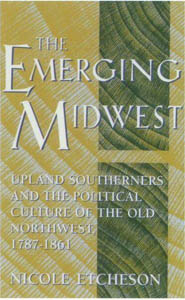|
A Review of The Emerging Midwest:
Upland Southerners and the Political
Culture of the Old Northwest, 1787-1861
by James E. Davis, Illinois College
This agile,
ambitious, and complex work analyzes
cultural and political dynamics of
upland southerners (hailing from
Maryland, piedmont Virginia,
North Carolina, Kentucky, and
Tennessee), who, in 1850, constituted over 90 percent of all southern-born Midwesterners in Ohio,
Indiana, and Illinois. Only selectively and somewhat tenuously
committed to southern slaveholders' values, they encountered
Yankees north of the Ohio River,
mixed and blended with them, and
created a melded culture that was
shaped by growing westernness
and the emergence of the second
party system. And during the
1850s, when northern onslaughts
and inept southern defenses shattered existing structures, some
upland southerners reaffirmed
upland southern ties, but most
rejected such appeals and demands
and remained at least tepid
Unionists. After the Civil War the
sundered Yankee-uplander culture
evolved and mended. Etcheson's
narrative unfolds within the context of tariffs, internal improvements, banks, slavery, race, the second party system, and crucial concepts of fairness. Across decades,
Etcheson notes, consensus that was
grounded in commitments to
republicanism, party, and westernness guided disputants.

|
This work encompasses untold
numbers of participants in vast
areas across scores of years. Tight
focus and organization, however,
save it from being thin or vacuous.
Various themes receive a chapter
each: statehood, manliness, interest, opportunity, rights, rekindled
sectionalism, and disunion, and a
conclusion traces the late-nineteenth-century evolution of personal characteristics perceived to be
Midwestern into the dominant
national identity. Within these
topics Etcheson skillfully weaves a
tapestry that is composed of varied
and rich threads of primary evidence. Having for decades used
some of the primary evidence that
Etcheson employed, I laud her judicious choices. Moreover, her command of pertinent secondary literature is impressive. This work, born
a dissertation, is jargon-free and
generally sparkles with stellar writing.
Her understanding of midwestern
uplanders' objections to the South's
threatening slave society and to
cutting Yankee attacks are thorough and insightful. Objections to
Yankees, she demonstrates, went
far beyond simple dislike of strident abolitionists and involved
spats over diet, education, women's
roles, concepts of masculinity, and
other cultural differences. She ably
analyzes uplanders' developing
ambivalence toward volatile issues:
efficacy of parties; elites; education;
the Kansas-Nebraska Act; immigrants, slavery, slave owners, and
blacks. Both the unfair Fugitive
Slave Act and blacks repulsed
uplanders.
Some blemishes surface, however.
Did national parties truly emerge in
the 1820s (p. 11)? Did uplanders,
many of whom engaged in small-scale speculation, typically "hate
speculators; the invidious land
monopolists..." (p. 93)? Were governments in the Old Northwest
really "colonial" (p. 16)? After
which year did the southern half of
Illinois have less manufacturing
than the northern (p. 75)? In addition, the notion of the monopolist
State Bank of Illinois needs elaboration, and uncertain and disjointed
chronology occasionally jars.
Finally, how does a person heading
downriver end up forty miles upriver (p.6)?
Caveats aside, this work succeeds
admirably; a paperback edition is a
fervent wish.
Copies of Nicole Etcheson's The
Emerging Midwest may be ordered
from Indiana University Press, 601
North Morton Street, Bloomington, IN
47404-3797 or by calling 800/842-6796. The price is $39.95.
Copyright ©1997 by the Southern
Historical Association. Reprinted with
permission of the Managing Editor.
|

